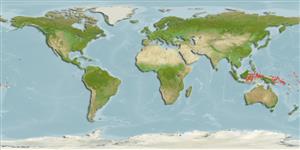Teleostei (teleosts) >
Eupercaria/misc (Various families in series Eupercaria) >
Lutjanidae (Snappers) > Lutjaninae
Etymology: Lutjanus: Malay, ikan lutjan, name of a fish.
Eponymy: David Mizenko worked for the National Marine Fisheries Service. [...] (Ref. 128868), visit book page.
Issue
Type locality: northeast of Apolima I., Western Samoa
Environment: milieu / climate zone / depth range / distribution range
Ecology
Marine; reef-associated; depth range 10 - 150 m (Ref. 55), usually 10 - 20 m (Ref. 90102). Tropical; 5°N - 16°S, 115°E - 166°W (Ref. 55)
Western Pacific: known only from Samoa and Indonesia (Sulawesi).
Size / Weight / Age
Maturity: Lm ? range ? - ? cm
Max length : 32.0 cm TL male/unsexed; (Ref. 48635)
Dorsal spines (total): 10; Dorsal soft rays (total): 13; Anal spines: 3; Anal soft rays: 8. Appears bright yellow underwater (Ref. 48635). Dorsal profile of head gently sloped. Preorbital bone narrower than eye diameter. Preopercular notch and knob poorly developed. Scale rows on back rising obliquely above lateral line. Back and sides reddish, grading to pink; the ventral portion of the head and body white; a series of faint, yellow horizontal lines on the sides; fins whitish or yellow. Juveniles are relatively slender and similar in shape to L. vitta (Ref. 48635).
Adults inhabit offshore reefs. Also deep coastal muddy reef slopes with reef outcrops and often on shipwrecks in depth over 20 m. Seen singly or in small aggregations (Ref. 48635). Occasionally seen at depths of 10-20 m (Ref. 90102).
Life cycle and mating behavior
Maturity | Reproduction | Spawning | Eggs | Fecundity | Larvae
Allen, G.R., 1985. FAO Species Catalogue. Vol. 6. Snappers of the world. An annotated and illustrated catalogue of lutjanid species known to date. FAO Fish. Synop. 125(6):208 p. Rome: FAO. (Ref. 55)
IUCN Red List Status (Ref. 130435: Version 2024-1)
Threat to humans
Harmless
Human uses
Fisheries: minor commercial
Tools
Special reports
Download XML
Internet sources
Estimates based on models
Preferred temperature (Ref.
123201): 28.1 - 29.1, mean 28.8 °C (based on 34 cells).
Phylogenetic diversity index (Ref.
82804): PD
50 = 0.5000 [Uniqueness, from 0.5 = low to 2.0 = high].
Bayesian length-weight: a=0.01479 (0.00706 - 0.03101), b=2.97 (2.80 - 3.14), in cm total length, based on LWR estimates for this Genus-body shape (Ref.
93245).
Trophic level (Ref.
69278): 3.8 ±0.7 se; based on size and trophs of closest relatives
Resilience (Ref.
120179): Medium, minimum population doubling time 1.4 - 4.4 years (Preliminary K or Fecundity.).
Fishing Vulnerability (Ref.
59153): Low vulnerability (22 of 100).
